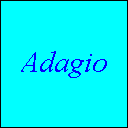 Tempo means time in Italian. The expression found
at the top left corner of the musical staff indicates how fast the music should be played.
The expression could be a word or a metronome marking.
Tempo means time in Italian. The expression found
at the top left corner of the musical staff indicates how fast the music should be played.
The expression could be a word or a metronome marking.
Italian Terms
adagio: very slow. allegretto: fairly quick, slightly slower than allegro. allegro: lively, rather quick. andante: rather slow, at a moderate, walking pace. andantino: this used to mean a little slower than andante, but now it usually means a little faster than andante. con moto: with movement, or a certain quickness. grave: extremely slow and solemn. largamente: broadly. larghetto: less slow than largo. largo: slow and broad. lentamente: slowly. lento: slow. moderato: moderate pace. prestissimo: as quick as possible. presto: very quick. rapido: rapid. veloce: with velocity. vivace: quick and lively.
German Terms
belebt: animated. breit: broad. breiter: broader. geschwinder: more rapid, swift. grossem: large, big. klagend: lamenting. langsam: slow. langsamer: slower. mässig: moderate. rasch: quick. schnell: fast. schneller: faster
French Terms
animé: animated. grande: large, great. grave: slow, solemn, deep slow. gravement: gravely, solemnly. lent: slow. vif.: lively. vite: fast.HISTORY
Tempo markings had been used since the early Baroque period, particularly with instrumental music. Not all instrumental music at that time had a tempo mark. Johann Sebastian Bach (1685-1750) often left out tempo marks in his keyboard music which was left to the discretion of the performer. The time of a piece was often determined by its purpose. Dance music was played at a certain tempo, depending on its style, so as to be danceable. Likewise, choral music had a certain tempo reflecting the mood of the text. Tempo markings became necessary to the point that Ludwig Van Beethoven (1770-1827) provided metronome markings instead of descriptive words.